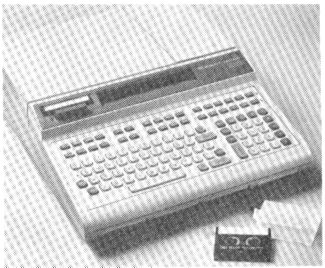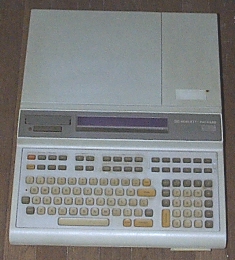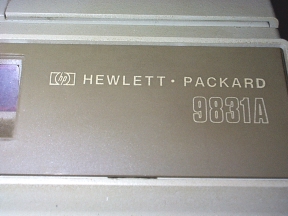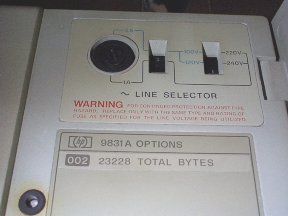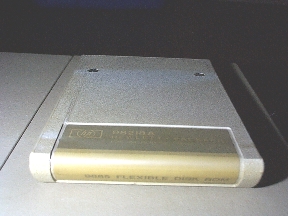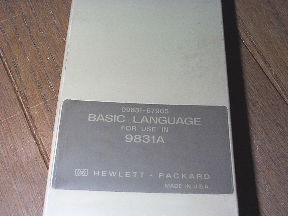|
Description
|
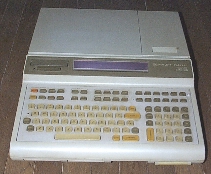 The Hewlett-Packard HP 9831 is a BASIC-language desktop computer introduced in mid-1977.
The Hewlett-Packard HP 9831 is a BASIC-language desktop computer introduced in mid-1977.
I am interested in finding any 9831 machines, ROMs, manuals, documents or other material, including information on the BPC processor. If you have any such equipment or documentation, please send me an e-mail! The 9831 is very similar in mechanical and electrical design to the 9825 and nearly identical software-wise to the 9830 desktop computer. In fact, most of the internal parts are prefixed with 09825, meaning they were originally designed for the 9825 computer. For instance, the keyboard assembly is 09825-66537. The 9831 BASIC operating system is incorporated into a slide-in ROM cartridge. It can replace the 9825A operating system and allow the 9825 machine to behave as a 9831. There were two different keyboards available for the 9831A: the "chicklet" style as pictured above, and a full-travel style shown below.
|
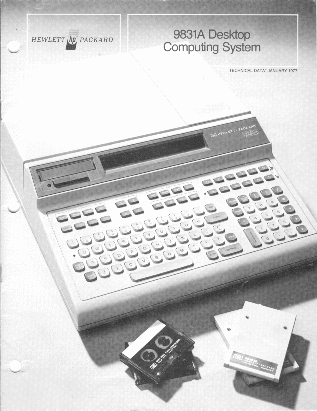 The HP 9831A is a desktop computer that can be used as either a stand-alone device
or with peripherals in an integrated computing system for industrial, commercial
and scientific applications.
The HP 9831A is a desktop computer that can be used as either a stand-alone device
or with peripherals in an integrated computing system for industrial, commercial
and scientific applications.
One of the main features of the 9831A is its programming language, the powerful BASIC (Beginner's All-purpose Symbolic Instruction Code). Because BASIC is a commonly known computer language and is similar to English, it's easy to learn and apply to programming skills. To increase the 9831A's capabilities, certain commands have been built in to handle alphanumeric string variables, advanced programming techniques, and input/output operations. In addition, you can work with up to 286 simple variables, 26 one- or two-dimensional arrays, and string variables which are limited only by the available memory space. Extra features like these provide you with greater programming flexibility. To further enhance the 9831A's capability and at the same time simplify programming even more, you are provided with 24 user-definable Special Function keys (12, plus shift) which can be used to represent text, functions, or entire programs. Three line editing keys and 4 character editing keys allow you to insert, change, and delete characters and lines as well as provide other programming debugging aids. Another special feature of the 9831A is the error message. If you make a mistake, such as mistyping a statement while programming, the word ERROR, a specified error number, and the line number in which the error occurred will appear on the light-emitting diode (LED) display. Each error message is also accompanied by a "beep". Built into the 9831A is a 2-track tape cartridge drive. The storage medium, a high-density rapid-access tape cartridge, records up to 250,000 bytes of information and also features automatic verification after recording. Other physical features of the 9831A include a 32-character LED display, a typewriter-link keyboard with upper- and lower-case alphanumerics, 3 input/output (I/O) slots for peripheral interfaces, and 4 read-only memory (ROM) slots. The 9831A comes standard with 7162 bytes of read/write memory all of which are available for your use because the BASIC language interpreter is hardwired into the machine. In addition, the memory can be expanded up to 31,738 bytes.
|
The 9831 (and 9825) use a three-chip central processing unit.
The three chips are:
The processor set is discussed in the June 1976 issue of the Hewlett-Packard Journal.
|
|
HP bundled the 9831 with two 8-inch disc drives, an impact printer
and a custom metal desk into a product called the 9896.
From the January 31, 1977 issue of Computerworld:
|
|
To increase its fundamental capabilities, specific commands have been built into
the 9831A, as previously mentioned. But, to further extend language capability
and peripheral control even further, 2 plug-in ROMs have been designed for use
with the 9831A - the 98218A Flexible Disk ROM and the 98223A/B Matrix/Plotter ROM.
The 98218A ROM contains statements and functions to fully regulate the 9885M Flexible Disk Drive. It gives you the capability for calling up a file by its preassigned name, instead of a complicated code. The 98223A/B ROM provides statements for matrix and array operations and for graphic output. The matrix commands are particularly helpful in speeding up large data manipulations. For example, the 9831 will invert a 20 x 20 matrix in about eight seconds. Plotter commands simplify control and programming effort. The A version of the 98223 contains statements necessary to control the 9862A Plotter, whereas the B version of the 98223 includes statements for the 9872A Plotter. |
|
Additional commands and capabilities were available by loading "binaries"
from tape.
There was a binary to add direct memory manipulation commands like PEEK and POKE. There was also a binary (called UNSECURE) that would unlock protected programs, allowing it to be LISTed.
|
|
|
|
|
|
|
|
The following HP devices were officially supported with the 9831A:
|
|
|
|
HP produced two memory upgrade kits to increase the amount of available RAM:
|
|
|
|
The 9831 only appeared in the 1978 catalog. The catalog copy read:
The HP 9831A is a destop computer that can be used as either a stand-alone device or with peripherals in an integrated computing system for industrial, commercial and scientific applications.
|
|
The 9831A was conceived in early 1976 as a business product for
the new Fort Collins Division (FCD), a spin-off of the
Calculator Products Division (CPD), which made the 98xx-series desktop
calculators (9810, 9820,
9830,
9825,
followed by the 9835 and 9845).
The 9831A project was known internally as "Bucs 77" because it was intended to generate immediate revenue in 1977 for the newly-created FCS while engineers worked to complete the new HP 200 small business computer. The idea was to port the 9830A BASIC firmware to the new 9825A hardware (which was 11 times faster than the 9830A) and then port the existing 9830A business applications (General Ledger, Accounts Payable/Receivable, etc.) to this new platform. The 9830A, introduced in 1972, had a discrete, 16-bit bit-serial processor with a CPU architecture based on the HP2100 series of computers. The 9825A was introduced in November 1975 and used a three-chip CPU set, again based on the 2100 series. At an assembly source code level, the 9830A and 9825A CPU's were about 90% compatible - the exceptions being the I/O and math. This compatibility was crucial, because it allowed the port to go very quickly. The 9830A BASIC code, minus math and I/O, was combined with the 9825A math and I/O code to produce the 9831A. (The rest of the 9825A HPL code was not used).
The initial product only supported the internal cartridge tape drive and an external 9885A 8-inch floppy drive for mass storage. Given that the 9830A BIMS (Business Information Management System) also supported the 7900A hard disks, and customers wanted the speed and capacity of a hard disk, a follow-on project was started almost immediately to add support for the new 7905A, 7906A, 7910A and follow-on hard drives to the 9831A. This involved going to California to time-share on the one-of-a-kind wire-wrap breadboard of the hard-drive-to-HPIB interface board. This follow-on project was completed in late 1977 or early 1978. Included in the 9830A development were some binaries to format and repack the floppy and hard disk drives. The UNSECURE binary was also produced but never released to customers (customers had to send their programs to Hewlett-Packard to be "unlocked"). Tools The tools used for the 9831A were an home-brew assembler/linker that ran on an HP 3000CX machine with 4 7900 4.7MB fixed/4.7MB removable cartridge disk drives and a single 120MB removable disk pack disk drive. There was only one 3000-series for all of CPD and FCD R&D - and the performance was horrible. On a good day, it took 5 minutes to read a 1,000-line source file into the editor. On a bad day, it was more than 20 minutes. Part of the reason was there were three different development projects going on at the time: new features for the 9825A, the 9831A, and the 9845A. In particular, the 9845A development was in a compiled language modeled after the SPL system programming language on the 3000. The compiler for the 9845A SPL was written in compiled BASIC, and was so large it sent the 3000 into complete disk thrashing because it couldn't fit into physical memory. When someone launched a compile, the hard disk light went solid "ON", and you could basically walk away for 30 minutes. Output from the assembler/linker was sent to paper tape and carried to the development system. Engineers used electric erasers fitted with a wheel and posts to spool up the paper tape which would be in a pile on the floor from the paper tape punch. Heaven help you if you stepped on the tape while spooling it and tore it! The debugger was a single-step tester called the "Nelson tester" since it was developed by a engineer, Lloyd Nelson. It had two rows of alphanumeric LED's, toggle switches and a few buttons. Later, it was replaced by a 9825A with a customer PC board that made debugging easier - but this newer version was too late for the 9831A. Once the code was finished, two different 2100 computers (one running DOS, the other RTE) were used to generate a hard ROM mask file image (the ROMs in the 9825/31/35/45 were 4K hard mask parts). These machines were only available after regular business hours as their primary function was IC layout. The tricky part of this process was that you had to tell the generating program what address the ROMs were to respond to: to do this, you had to take bits 15-11 of the address, reverse them, and give it to the program. On one ROM revision, Art got bits 14-10 instead, so the ROM responded to the wrong address, and had a disaster one week before release! The team did a very fast mask turn (3 days from finding the problem to new masks), then had a fab disaster where they forgot to put the nitride passivation on the replacement parts. Ah, the bad old days before EPROMs and flash memory! The hard disk option for the 9831A came out about a year after the initial 9831A release. This required new system ROMs and an additional front plug-in ROM. It added support for the 7905A and 7906A hard drives, and had provisions to work with the then-future 7910A/12/14/25A drives (never officially supported, but were supposed to work). |
|
One publication that carried the announcement of the 9831 was
the May 1977 issue of IEEE Spectrum magazine.
Desktop Basic computer has 8k bytes of memory The May 1977 COMPUTER magazine also carried an announcement: The September 1976 issue of SIGNAL magazine carried a truncated version of this announcement.
|
|
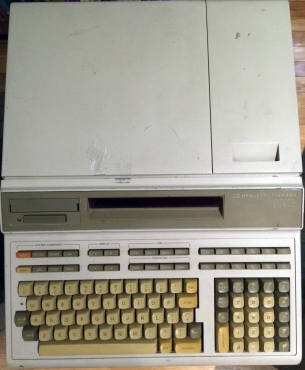
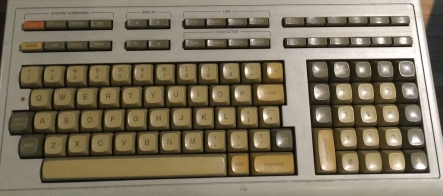
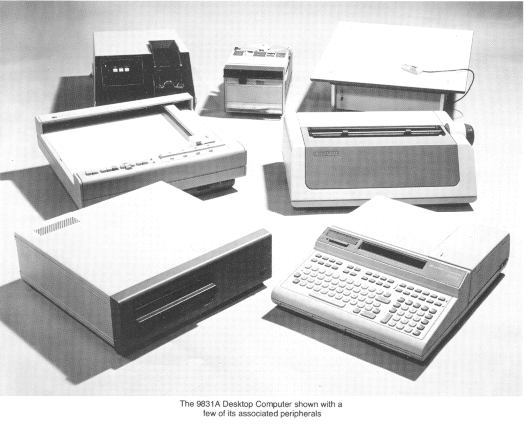 The 9831A also allows flexible system expansion to meet your application's needs.
You can choose from a variety of peripherals and software packs to configure a
truly personalized desktop computing system.
The 9831A also allows flexible system expansion to meet your application's needs.
You can choose from a variety of peripherals and software packs to configure a
truly personalized desktop computing system.
 The project team consisted of three people: software engineer Art Boyne,
a part-time mechanical engineer (relabeling, and removing the 9825A
strip printer), and a summer intern to do firmware quality assurance (QA) testing. It was
introduced in about September or October 1976, so the project took only
about 9 calendar months to complete. Except for the strip printer and
the replacement ROM drawer and plug-in option ROMs, the 9831A and 9825A
hardware was identical, and the 9831A ROM drawer could be directly used
in a standard 9825A.
The project team consisted of three people: software engineer Art Boyne,
a part-time mechanical engineer (relabeling, and removing the 9825A
strip printer), and a summer intern to do firmware quality assurance (QA) testing. It was
introduced in about September or October 1976, so the project took only
about 9 calendar months to complete. Except for the strip printer and
the replacement ROM drawer and plug-in option ROMs, the 9831A and 9825A
hardware was identical, and the 9831A ROM drawer could be directly used
in a standard 9825A.
